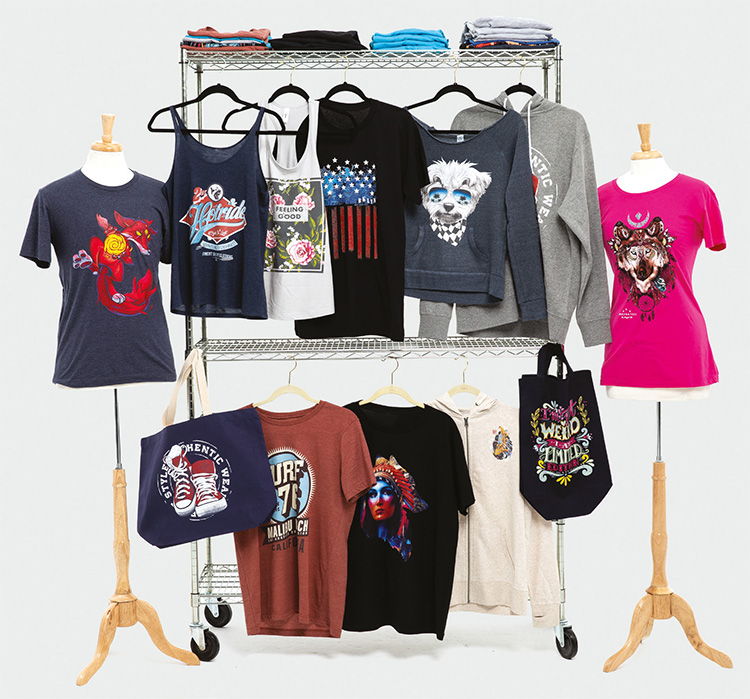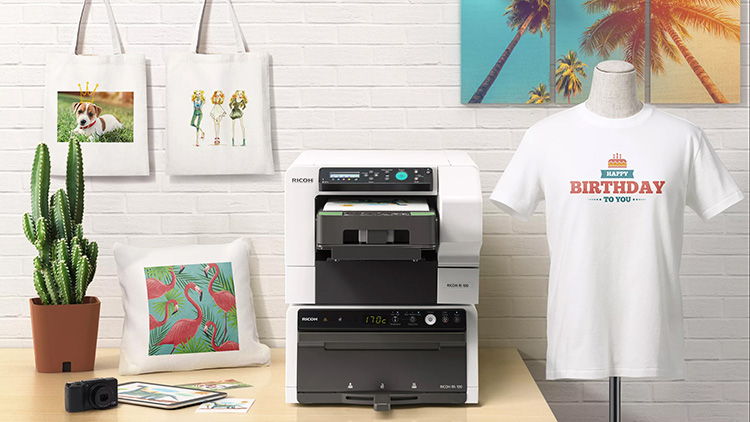If you want to start a new garment printing business, or replace your current T-shirt printing technology, there are probably more options available to you now than ever before.
Cost is, as always, a consideration, but print buyers and consumers have several other demands. It's necessary to consider minimum order quantities, print quality, speed of delivery and personalisation, all of which will affect your buying options.
To decide which garment printing technology is right for you, it's essential to understand the differences, benefits, and disadvantages of each.
Direct to garment (DTG)
Direct to garment printing, or DTG, utilises purpose-designed inkjet printers that apply water-based pigment inks directly to cotton and cotton/polyester garments and fabrics. Typically, these printers, such as the Ricoh Ri 100 and Ri 1000, have a small footprint, shallow learning curve and affordable ROI, making them ideal for start-ups or businesses expanding into printing T-shirts, sweatshirts, and tote bags. The eco-friendly inks may include white, which can be printed as a base to eliminate show-through and make graphics on dark coloured garments as vibrant as on white tees.
DTG printers are digital systems, which means the design can be tweaked or changed entirely from one garment to the next easily, enabling the production of personalised products quickly. Individual ink colours are printed in perfect registration, with half tones, transparent backgrounds and photos all printed beautifully with a soft texture. However, the colour gamut on DTG is limited, with speciality inks and Pantone Matching System (PMS) colours not supported, and only cotton and polycotton blends are printable.
Dye sublimation
Dye sublimation – often shortened to dye sub – is a digital technology that allows excellent garment personalisation options on polyester, even across the entirety of a garment. The process involves printing an image onto release paper using a dye sublimation inkjet printer, which is then transferred to the garment using heat and pressure. A specialist dye sublimation solution is required, but these machines normally have a small footprint and low initial set-up costs. Colours are printed in accurate registration with a soft finish, but there are limitations. It is not possible to print a true black nor with white ink, and white polyester is the only compatible material. In addition, images must be printed in reverse, which could be tricky for new users to master.
Heat transfer
This technology involves printing an image onto specialist paper using a laser printer and, as the name suggests, transferring it to the garment using heat. This is an easy and affordable way to start printing T-shirts and other clothing because many standard desktop printers are capable of printing the initial design – personalised to order. However, like dye sub, images must be printed in reverse and trimmed, making the process quite fiddly. It's also necessary to use specialist paper or alternative techniques to apply a white base layer on dark garments to achieve the best results. Furthermore, the finished printed image is non-breathable, feels stiff to the touch and doesn't wash well, potentially giving the garment a vintage appearance well before its time. Owing to the small format nature of the printer and paper, both designs and production volumes are limited in size.
CAD cut vinyl
For this garment decoration process, simple designs – letters, numbers, logos, shapes – are cut from a special vinyl material with a cutting machine or plotter and transferred to a T-shirt using a heat press. This vinyl is available in a fantastic variety of colours and effects, including metallic, fluorescent and flock, and is compatible with a wide range of fabrics in any colour. This makes CAD cut vinyl printing an effective, low-cost way to create one and two-colour messages on lots of different garments and products. Drawbacks include poor washability and stiff texture, significant limitations on design, and lack of suitability for long production runs.
Screen printing
Screen printing is an industrial print process, predominantly used for long print runs. Inks are pressed through a mesh screen or stencil onto the garment with a blade or squeegee, with each colour requiring a separate screen which must be aligned accurately to ensure good registration. It's possible to achieve some incredible designs on a wide range of materials, thanks to PMS colours and speciality inks, and the finish is washable and durable.
Screen printing is an investment for established businesses: screen presses are expensive to buy and take up a lot of space, making them not cost effective for low to medium production volumes. Users should also be aware that solvents are used in the cleaning process, so workspaces will need proper ventilation. Furthermore, as an analogue print process, screen printing does not support easy personalisation; a new screen press is needed for every new design.
If you've considered these technologies and think direct-to-garment may be the best fit for your T-shirt and garment printing business, take a look at this online tutorial (https://www.youtube.com/watch?v=N7JAHO3bsHo&t=6s) or visit our website (https://products.ricoh.co.uk/direct-to-garment) to find out more.
Authored by Nick Macfarlane, Direct to Garment Sales Specialist, Commercial and Industrial Printing Group, Ricoh
For further information on Ricoh wide-format products and services, please click here






